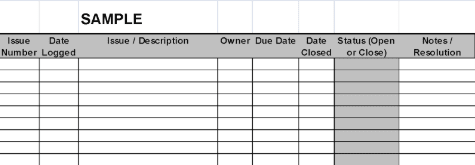Project Issue Management Process Template – Tronmaster.com

The Issue Management Process is essential for logging, tracking, diagnosing, and escalating issues as they arise. This process facilitates structured oversight to ensure issues are addressed efficiently and that critical support channels are activated when necessary.
Regular weekly meetings and monthly status reports will be held to monitor issue progress and encourage open discussion among stakeholders, helping to preempt additional issues.
Roles and Responsibilities
1. Issue Owner (IO):
- The individual responsible for submitting the issue to the Issue Manager.
- Takes lead on issue resolution once assigned.
2. Issue Manager (IM):
- Responsible for logging, tracking, and updating issues in the Issue Management Log.
- Oversee the lifecycle of each issue, from logging to closure.
Issue Management Log Structure
Each logged issue will contain the following fields:
Field Name
Description/Content
Issue Number
Unique identifier assigned by the Issue Manager.
Date Logged
Date on which the issue is recorded by the IM.
Issue/Description
Brief description outlines the nature of the issue.
Owner
Person submitting the issue (Issue Owner).
Due Date
Target or required date for issue resolution.
Date Closed
Date when the issue is officially resolved.
Status
Current status (e.g., Open, Closed).
Note/Resolution
Comments, updates, and details on the issue resolution.
The Issue Management Process
The Issue Management Process involves six key steps:
1. Issue Analysis and Logging
- The Issue Owner (IO) submits the issue to the Issue Manager (IM).
- IM assesses whether there are immediate solutions or if further guidance is required.
- The issue is documented in the Issue Management Log.
2. Issue Assignment
- Unassigned issues are presented in project team meetings.
- The project team reviews the issue and designates an Issue Owner (IO) responsible for resolution.
3. Issue Resolution
- The IO identifies potential solution options and develops a detailed resolution and implementation plan.
- The IO presents the resolution plan to the project team and any relevant stakeholders.
- Upon approval, the IO implements the solution and ensures its effectiveness.
- The IM records the resolution in the Issue Management Log and marks the issue as closed.
4. Issue Tracking
- The IM reports on unresolved issues during project staff meetings.
- The IO provides updates on resolution progress during meetings and to key stakeholders.
- IM updates the Issue Management Log with progress details.
- Upon successful resolution, the IM closes the issue and logs final comments.
5. Issue Escalation
- If needed, the IO or Project Manager can escalate the issue for additional support.
- Escalated issues are reviewed by the project team for further action.
- The Project Manager may consult the project sponsor for guidance if needed.
- The IM maintains oversight until the issue is fully resolved.
6. Issue Closure
- Once a solution is implemented, the IO verifies successful resolution and reviews results with management.
- The IM logs the closure in the Issue Management Log, completing the issue lifecycle.
Issue Management Log
The Issue Management Log serves as the central record of all issues, tracking each issue from submission through to closure. It provides visibility and accountability, ensuring issues are addressed timely and documented thoroughly.
Issue Management Log

Let’s Elevate Your Business
Ready to take your business to the next level? At Tronmaster, LLC, we specialize in helping companies achieve efficiency and growth through expert IT solutions. Reach out today and let us know how we can support your success. Let's build a more efficient future together.